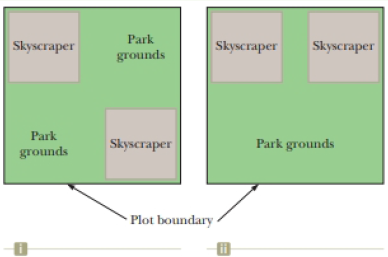
Concept explainers
You are working as an expert witness for the owner of a skyscraper complex in a downtown area. The owner is being sued by pedestrians on the streets below his buildings who were injured by falling glass when windows popped outward from the sides of the building. The Bernoulli effect can have important consequences for window’s in such buildings. For example, wind can blow around a skyscraper at remarkably high speed, creating low pressure on the outside surface of the windows. The higher atmospheric pressure in the still air inside the buildings can cause windows to pop out. (a) In your research into the case, you find some overhead views of your client’s project, as shown below. The project includes two tall skyscrapers and some park area on a square plot. Plan (i) (Fig. P14.26(i), page 382) was submitted by the original architects and planners. At the last minute, the owner decided he didn’t want the park grounds to be divided into two areas and submitted Plan (ii) (Fig. P14.26(ii), which is the way the project was built. Explain to your client why Plan (ii) is a much more dangerous situation in terms of windows popping out than Plan (i). (b) Your client is not convinced by your conceptual argument in part (a), so you provide a numerical argument. Suppose a horizontal wind blows with a speed of 11.2 m/s outside a large pane of plate glass with dimensions 4.00 m × 1.50 m. Assume the density of the air to be constant at 1.20 kg/ m3. The air inside the building is at atmospheric pressure. Calculate the total force exerted by air on the windowpane for your client. (c) What If? To further convince your client of the problems with the building design, calculate the total force exerted by air on the windowpane if the wind speed between the buildings is 22.4 m/s, twice as high as in part (b).
Figure P14.26

Want to see the full answer?
Check out a sample textbook solution
Chapter 14 Solutions
Physics for Scientists and Engineers
Additional Science Textbook Solutions
College Physics: A Strategic Approach (3rd Edition)
General, Organic, and Biological Chemistry - 4th edition
Microbiology Fundamentals: A Clinical Approach
- 8. With the aid of a diagram draw the following electric circuit and use the resistor as the load, (a) Closed circuit (b) Open circuitarrow_forwardLab 8 Part 3 PHET Wave Interface simulation. I am having trouble with this part of the lab.arrow_forwardMick and Rick are twins born on Earth in the year 2175. Rick grows up to be an Earth-bound robotics technician while Mick becomes an intergalactic astronaut. Mick leaves the Earth on his first space mission in the year 2200 and travels, according to his clock, for 10 years at a speed of 0.75c. Unfortunately, at this point in his journey, the structure of his ship undergoes mechanical breakdown and the ship explodes. How old is Rick when his brother dies?arrow_forward
 Principles of Physics: A Calculus-Based TextPhysicsISBN:9781133104261Author:Raymond A. Serway, John W. JewettPublisher:Cengage Learning
Principles of Physics: A Calculus-Based TextPhysicsISBN:9781133104261Author:Raymond A. Serway, John W. JewettPublisher:Cengage Learning Physics for Scientists and Engineers: Foundations...PhysicsISBN:9781133939146Author:Katz, Debora M.Publisher:Cengage Learning
Physics for Scientists and Engineers: Foundations...PhysicsISBN:9781133939146Author:Katz, Debora M.Publisher:Cengage Learning Physics for Scientists and EngineersPhysicsISBN:9781337553278Author:Raymond A. Serway, John W. JewettPublisher:Cengage Learning
Physics for Scientists and EngineersPhysicsISBN:9781337553278Author:Raymond A. Serway, John W. JewettPublisher:Cengage Learning Physics for Scientists and Engineers with Modern ...PhysicsISBN:9781337553292Author:Raymond A. Serway, John W. JewettPublisher:Cengage Learning
Physics for Scientists and Engineers with Modern ...PhysicsISBN:9781337553292Author:Raymond A. Serway, John W. JewettPublisher:Cengage Learning College PhysicsPhysicsISBN:9781938168000Author:Paul Peter Urone, Roger HinrichsPublisher:OpenStax College
College PhysicsPhysicsISBN:9781938168000Author:Paul Peter Urone, Roger HinrichsPublisher:OpenStax College College PhysicsPhysicsISBN:9781305952300Author:Raymond A. Serway, Chris VuillePublisher:Cengage Learning
College PhysicsPhysicsISBN:9781305952300Author:Raymond A. Serway, Chris VuillePublisher:Cengage Learning





